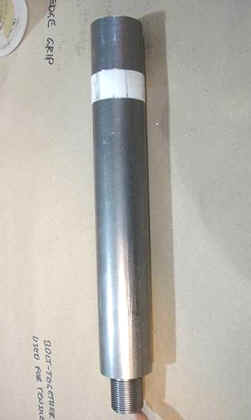
Design
Adaptation of an ATS-1600 was the principle purpose of this design.

Upper and lower attachments had to be made to fix our samples into the ATS-1600. These attachments had to be able to withstand the force created by the thermal expansion of the aluminum samples. In addition to withstanding the forces created by the aluminum they have to be able to protect the load cell in the crosshead of the ATS-1600 from the high temperatures produced by the oven. To suit both of these task, two 2" diameter steel rods with threaded ends were used to attach the sample to the ATS-1600 and the load cell. Sandwiched in between these rods are two macor segments that will provide thermal insulation to protect the load cell. To provide added protection for the load cell copper tubing was wrapped around the top steel rod and cold water was circulated through it. These attachments were then threaded onto the ATS-1600 and the aluminum samples were held between them by the use of a small indentation in the steel to hold it in place.

Sample Holders
Shown above is the completed sample holder with the steel rod at the bottom, then the macor, and the steel sleeve at the top.


Because of the slow cooling rate, forced convection was inducted. To do this copper tubes were attach to the lower steel rod and then aimed at the aluminum sample. These were then attached to a air supply line. Once the oven was opened the air could be turned on and the sample would be rapidly cooled to room temperature. Copper tubes where also added to the top steel sleeve with moving water to increase heat loss and protect the load cell from overheating.

Final Setup
This is the final setup up for the ATS-1600. This includes both sample holders, aluminum sample, oven, and the cooling accessories.